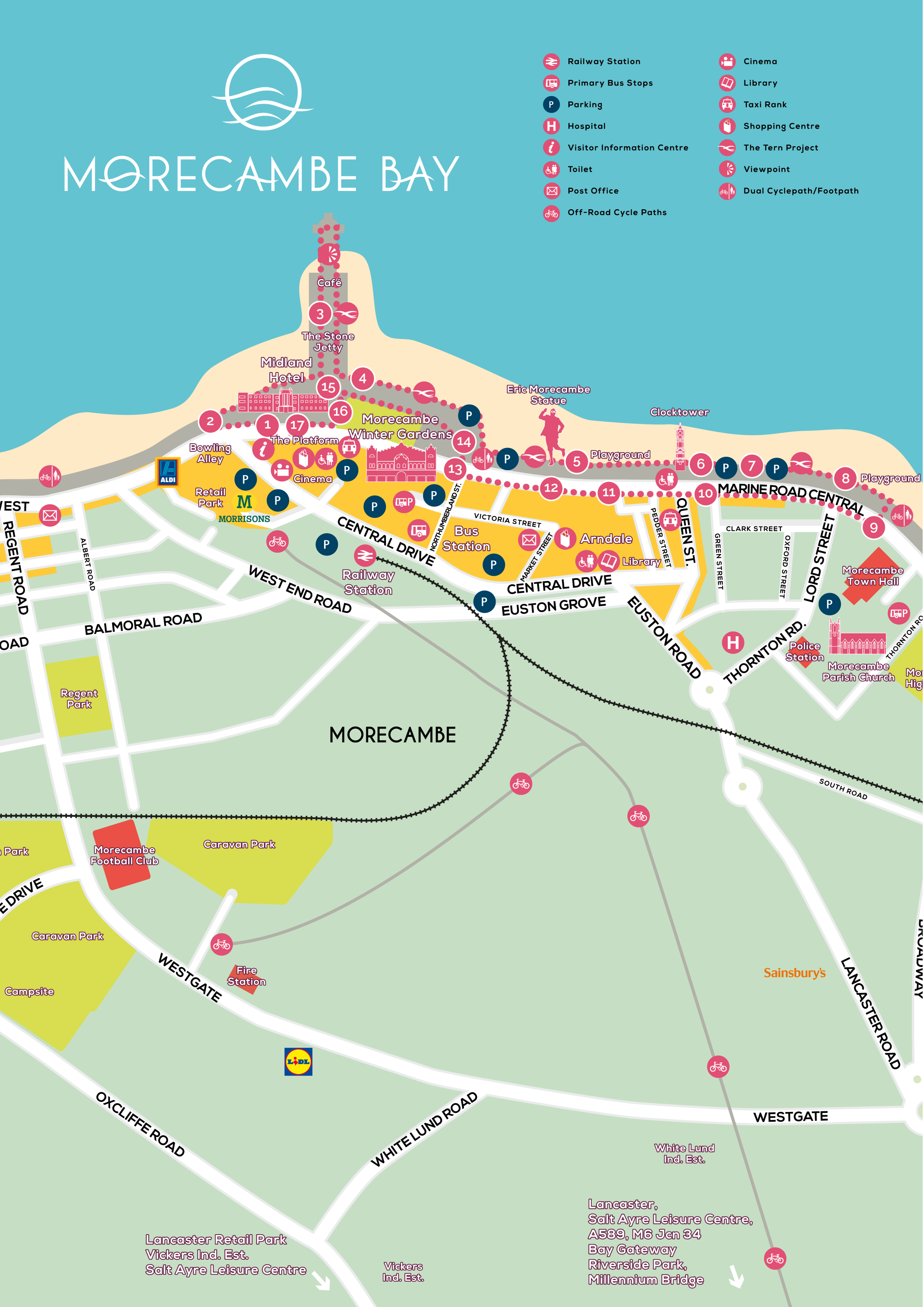Morecambe Heritage Trail - self guided walking trail

Let's begin at The Platform, located In The Old Station building, site of the old Morecambe Promenade Station first opened to passengers in 1907 as the point of arrival for the large influx of holidaymakers from Bradford, Leeds and Scotland.
Cross Marine Road then turn left through the gap in the wall onto the promenade. Here you will find the starting point for the Way of the Roses, a 170-mile coast-to-coast cycle route from Morecambe to Bridlington on Yorkshire's east coast.
Head along the promenade with the Midland Hotel on your right (more about this iconic building later) to the end of the Stone Jetty. This marks the site of Morecambe's former harbour, built around 1853. The Stone Jetty was rebuilt in 1995 and now hosts a series of artworks and pavement games that were created as part of the TERN' project. The 5uilding near the end, now a cafe, was originally a passenger and cargo railway terminal which was built to meet the bay's steam ferry. It was later the site of Ward's Shipbreaking Yard - a controversial but lucrative industry for Morecambe during the 1920s.
Walk back down the Stone Jetty and turn left towards the RNLI Hovercraft Station. Although there has been a lifeboat station in Morecambe for over 50 years, the first rescue hovercraft (The Hurley Flyer) was launched from the station in 2002.
Stay on the promenade until you reach the Eric Morecambe statue. This statue, created by sculptor Graham lbbeson, is part of the previously mentioned TERN project and depicts Eric Morecambe in one of his characteristic poses with a pair of binoculars around his neck.
Born in Morecambe in 1926, John Eric Bartholomew was one of the most loved British comedians. He was also a keen ornithologist and loved Morecambe Bay for its natural diversity and the opportunity to view the spectacular flocks of seabirds feeding on the sandflats and saltmarshes.
Carry on along the promenade to the Clock Tower, now a Grade II listed building. Made of red brick and sandstone, it was a gift to the town from Alderman J.R. Birkett.
A little further along the promenade you can find the Lakeland Panorama, designed by Russell Coleman. This series of oxidised steel panels shows the dramatic mountain skyline that can be seen across Morecambe Bay. See if you can pick out Hard Knott. Coniston Old Man, and Helvellyn.
As you continue along the promenade you will pass the RNLI Lifeboat Station and then reach the Morecambe Sailing Club Race Office building. The club was started in 1936 by local fishermen who liked to race their boats - and it is still open for membership. For centuries fishing has been one of the main industries of the bay: with shrimps, cockles, mussels and whitebait being caught: although traditional methods using horses and carts have given way to today's tractors, trailers and quadbikes.
Morecambe Bay is also a fantastic location for exhilarating outdoor sports but with its shifting sands and changing tide channels it can be unpredictable. It is always safer to undertake activity with a recognised organisation or guide. A Cross Bay Walk, led by the royally-appointed 'King's Guide to the Sands' is a great way to discover the breath-taking beauty of the bay. Find out more at www.guideoversands.co.uk.
From the Sailing Club Race Office cross Marine Road to Morecambe Town Hall, opened in 1931. In the foyer, a beautiful cantilevered stone staircase ascends above a central mosaic panel set into the entrance hall flooring which carries the town's motto: 'Beauty Surrounds. Health Abounds'.
Leave the Town Hall and head back along Marine Road, passing some of the town's large hotels, formerly gentleman's residences. Sadly, they no longer look out over one of Morecambe's two former piers, Central Pier, which opened in 1869 but was demolished in 1992 after being damaged by fires in 1987 and 1991. The 912-foot structure included a pier head for the steamers that ran until 1914, plus a ballroom, roller-rink, cafe and later an amusement arcade. Today the Old Pier Bookshop - a glorious riot of narrow corridors and piled books - and The Pier Hotel sit opposite its former site.
As you walk back along Marine Road, look left by the Treasure Island building where you will see the beautiful former Barclays Bank building with its lead spire, built around 1900 in a Bavarian style.
This precinct leads through to Morecambe's main shopping area where you will find the ‘Eric Bartholomew' pub which houses memorabilia of local entertainers, and The Arndale Centre (on the site of the Old Royalty Theatre) where you will find a number of high street stores plus Morecambe Heritage Centre which displays changing exhibitions charting Morecambe's maritime, railway, leisure and military history. (Heritage Centre open Tues, Thur, Sat 11am - 4pm: admission free.)
As you pass the former Palladium Cinema, look up to see the former 'ghost-sign', lovingly restored in 2014. Great pains were taken to match the vivid colours and fluid styling of the original - likely to have been painted freehand by a signwriter working without scaffolding whilst buffeted by the bracing winds whistling in from the bay!
As you near the famous Winter Gardens buildings you will pass Brucciani's. Originally opened as a Milk Bar by Bruno Brucciani in 1939, its traditional décor evokes memories of the tourists who tucked into local seafood and its signature Knickerbocker Glory.
Then take a step back to view the splendour of Morecambe's Winter Gardens building. Once known as the Victoria Pavilion, it opened in 1897 and could seat over 2000 people. It contained a ballroom, bars, a billiard hall and even an aquarium. It hosted music hall performances and wartime concerts before featuring stars including Alma Cogan and Shirley Bassey. The Friends of the Winter Gardens have been working since 1986 to return it to its former glory and the building currently hosts events, tours and even ghost hunts!
Cross back towards The Midland Hotel. On the site of the former North Western Hotel, it was built in 1933, designed by architect Oliver Hill, with murals by Eric Ravilious and sculpture by Eric Gill which can still be seen today. During the Second World War it was requisitioned by the RAF as a hospital. After falling into disrepair, refurbishment was completed by Urban Splash in 2008 to an Art Deco-inspired design.
As you look out from the Sun Terrace of The Midland, you can see to your right the site of the former Super Swimming Stadium. A mile-long queue awaited its opening in July 1936 when it was claimed to be the biggest outdoor pool in Europe. After World War Two it became the venue for Miss Great Britain competitions and, despite the reportedly freezing temperatures of the water, it remained wildly popular throughout the 50s and 60s. This area is now the site for the proposed Eden Project North.
Return to The Old Station Buildings - enjoy a drink in The Station, a browse around the Festival Market or an evening of entertainment at The Platform!















